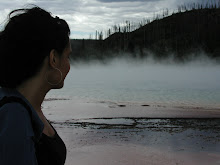



Because abundance emerged beneath the messy promise, 2010, acrylic, found foam, pencil, paper, moss, Photo transfer, pine cone, sedum, sponge, wood, 35 x 29 x 5, Spread on moment’s falling over the warm grid, 2010, Acrylic, Pencil, Sponge, Moss, Lead, Wood, Cigarette butts, Sedum, grass, wax, 18 x 24 x 9.5, Produced within the layers of viewing’s making, 2009, Acrylic, Buckthorn root, Cedar, found foam, insulation foam, Moss, palm, paper, pencil, photo transfer, satin ribbon, Sedum, sponge, 23 x 29 x 4, Looming, 2009, Acrylic, Cedar, found foam, leaves, Moss, pencil, photo transfer, pine needles, polyurethane foam, Sedum, sponge, 23 x 29 x 7
i'm so loving these....see tons more here.When I am in nature I experience the world through all of my senses in a dynamic way, but at the same time I am framing what I see through the cultural expectations I have absorbed through representational systems such as landscape painting, wildlife documentary, and travel guides. It is very difficult, then, to have a true, non-mediated experience of nature even though I may long for it. My work explores the contradictions between the projection of idealized, picturesque views of landscape and my desire to have an authentic experience in nature.
My recent compositions contain a mixture of landscape images painted on paper, which have been shaped into three-dimensional sculptures that protrude from the wall. The battered and wrinkled sheets of paper that are the foundation of these works carry a blend of imagery containing picturesque landscapes drawn from memory, photo transfers based on nature photography, abstract areas of raw paint, and actual artifacts from the land such as pine needles and bark. By employing multiple representational modes, I create tension between the cultural codes traditionally used to represent landscape. For example, pools of thick, raw, liquid paint at once expose the illusion of representational systems and mimic the properties of the rivers and streams they are used to signify. Similarly, the exaggerated folds of the thick watercolor paper transform the flat, framed image of the traditional landscape into a dimensional topography that cannot be completely owned from one vantage point. The three-dimensional forms of these new terrains -- painted on both sides and containing hidden vignettes -- encourage the kind of
exploration one might find in nature rather than a traditional picture.




No comments:
Post a Comment